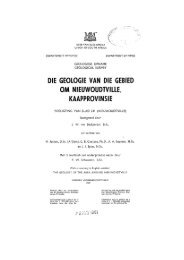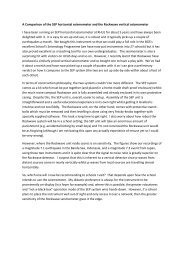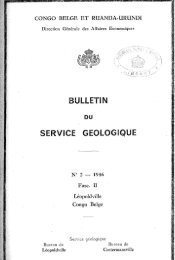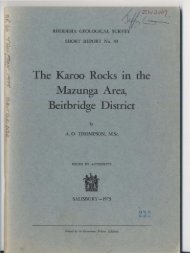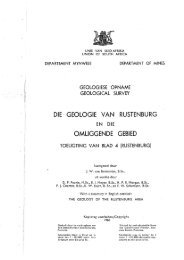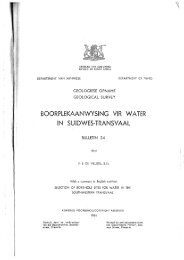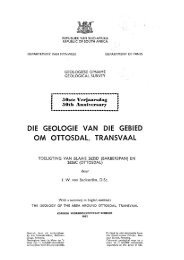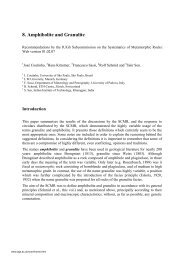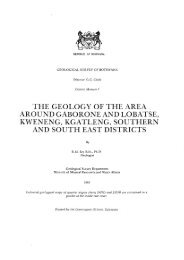Bibliography - British Geological Survey
Bibliography - British Geological Survey
Bibliography - British Geological Survey
Create successful ePaper yourself
Turn your PDF publications into a flip-book with our unique Google optimized e-Paper software.
Matthew, W. D. 1916. Note on the association of the Piltdown skull and jaw. Appendix B in W. K.<br />
Gregory. Bulletin of the American Museum of Natural History, 35, 348–350.<br />
Matthew, W. D., Eastman, C. R. & Gregory, W. K. 1916. Recent progress in vertebrate paleontology.<br />
Science, 43 (21 Jan), 103–110. (Including a discussion, by Matthew, of the Piltdown skull and jaw, pp. 107–<br />
108, which entirely supports G. S. Miller’s conclusions that the latter belongs to a chimpanzee. ‘It is hardly<br />
to be expected, however, that this conclusion will be readily accepted by the European writers, who have<br />
with few exceptions committed themselves more or less deeply to the opposite view.’)<br />
Matthews, L. H. 1981. Piltdown man: the missing links. New Scientist, 90: (30 Apr), 280‒282; (7 May),<br />
376; (14 May), 450; (21 May), 515‒516; (28 May), 578‒579; (4 Jun), 647‒648; (11 Jun), 710‒711; (18 Jun),<br />
785; (25 Jun), 861‒862; 91 (2 Jul), 26‒28. (This interpretation of events at Piltdown reads largely as a work<br />
of fiction in which Dawson, starting with an old primitive-looking skull given to him in 1906 by a Mr Burley<br />
of Nutley, near Piltdown, attempts with the help of Lewis Abbott to construct a hypothetical assemblage of<br />
the same age as Heidelberg Man, including a faked jaw. In submitting part of the skull to Smith Woodward,<br />
and having convinced himself that it had been found at Piltdown, Dawson overstates his case by including a<br />
hippo tooth given him by Teilhard de Chardin. He is subsequently obliged to plant evidence when the site<br />
itself fails to yield any finds. Teilhard, it seems, suspects a deception, as does Martin Hinton, a voluntary<br />
worker at the NHM, and the two conspire to plant the canine tooth in order to warn off Dawson. This fails,<br />
and Hinton alone then plants the bone implement, with the same negative result. Also implicated through<br />
having had knowledge of Hinton’s complicity is C. P. Chatwin, an assistant at the NHM, who later worked<br />
for the <strong>Geological</strong> <strong>Survey</strong>. Harrison Matthews evidently knew Hinton well during the period 1945–51, but<br />
admits that although Hinton was dismissive of Piltdown, nothing of substance was ever said on the subject.<br />
The series of papers prompted reactions from Costello 1981b, Oakley 1981, and Townshend 1981.)<br />
Maxwell, J. 2012. Piltdown Man and other hoaxes: a book about lies, legends, and the search for the<br />
missing link. American Book Publishing, 248 pp.<br />
McCann, T. 1981. Charles Dawson and the Lavant Caves. Sussex Archaeological Society Newsletter, no. 33<br />
(Apr), 234. (Charles Dawson and John Lewis carried out a detailed excavation of the Lavant Caves, at the<br />
request and at the expense of the 6th Duke of Richmond, shortly after the discovery in 1890 of subterranean<br />
passages cut into the Chalk at Hayes Down, East Lavant, near Chichester. The excavation was undertaken<br />
during 1893, but the only published account that appeared was a report in The Sussex Daily News of 11 Aug<br />
1893 based on a presentation by Dawson to the Sussex Archaeological Society. A number of roof collapses<br />
forced the abandonment of the excavation, with the result that no official report was ever published. A manuscript<br />
report does however survive in the West Sussex Record Office at Chichester, the content of which is<br />
briefly summarised. There are aspects of the affair, such as the suspicious nature of the few artefacts found,<br />
that are considered to reflect badly on Dawson: see in particular Allcroft 1916, Russell 1999, Russell 2003,<br />
33–41. Clinch 1905 includes a plan of the workings supplied by Lewis. See Holden 1981, McCann 1997.)<br />
McCann, T. J. 1997. The Lavant Caves revisited. Sussex Archaeological Collections, 135, 311. (The writer<br />
has discovered a diary record of a visit to the Lavant Caves undertaken on 10 Mar 1893, by Mary Wyndham,<br />
the daughter of the 2nd Lord Leconfield, which is quoted. She notes, reflecting the view of Charles Dawson,<br />
that ‘It is supposed to have been inhabited by ancient Britons, & a few ornaments have been found.’ Allcroft<br />
1916 suggested that the site had been a flint mine, but the modern view (Russell 2003, 38) is that it is the<br />
result of post-medieval chalk extraction.)<br />
McCulloch, W. 1981. Some remarks on Teilhard and the Piltdown hoax. Teilhard Newsletter, 14 (1), 1–2,<br />
4. (A response to Gould’s accusation of Teilhard de Chardin’s complicity in the Piltdown affair. Gould<br />
enlisted the views of the late L. S. B. Leakey in his argument, but the writer points out that Leakey could<br />
never discover any evidence to support his suspicion, as is clear from a letter addressed to Oakley in Sept<br />
1972, just a month before his death. After dealing with each of Gould’s arguments, the writer concludes that<br />
what Gould calls his ‘complex hypothesis’ is contradicted by basic facts.)<br />
McCulloch, W. 1983. A reader’s guide to S. J. Gould’s Piltdown argument. Teilhard Newsletter [or<br />
Perspective?], no. 16, Dec, 4-7.<br />
McCulloch, W. 1996. Teilhard de Chardin and the Piltdown hoax. Teilhard Studies, no. 33.<br />
McGrath, P. 1987. Book review [Peter Marks, Skullduggery]. New York Times Book Review, 23 Aug, 7.11.<br />
(See response by Blinderman 1987)



